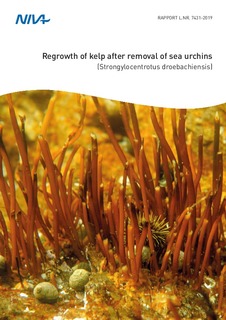| dc.contributor.author | Carlsson, Pernilla Marianne | |
| dc.contributor.author | Christie, Hartvig C | |
| dc.date.accessioned | 2019-11-29T12:10:53Z | |
| dc.date.available | 2019-11-29T12:10:53Z | |
| dc.date.created | 2019-11-28T09:35:25Z | |
| dc.date.issued | 2019 | |
| dc.identifier.isbn | 978-82-577-7166-9 | |
| dc.identifier.uri | http://hdl.handle.net/11250/2631065 | |
| dc.description | Project manager Pernilla Carlsson | nb_NO |
| dc.description.abstract | With few natural predators, green sea urchins (Strongylocentrotus droebachiensis) have grown in numbers, grazed down large kelp forest areas in Northern Norway into urchin barrens. NIVA deployed three underwater cages outside Tromsø, Northern Norway during Autumn 2018, removed all urchins within these cages and followed the cages closely until Summer 2019. The first kelp individual was observed in the middle of March, and by the end of May, the seafloor in the cages were covered with 80-100% of algae, especially brown algae Desmarestia sp. and Alaria esculenta. Sugar kelp (Saccharina latissima) was also present. The study showed that kelp species could re-establish in cages where sea urchins were kept at low abundance. However, once kelp had re-established, the area inside the cages increased in interest for the sea urchins, who climbed into the cages and grazed on the algae. This small scale pilot-project would need an up-scaling of cage sizes and cleaning efforts to improve the survival rate of the kelp. At present, the density of urchins in Troms are probably sufficiently high to allow a sustainable sea urchin harvesting. However, research is needed to assess the required harvested amount of sea urchins to promote kelp forest recovery, and at the same time allow the sea urchin industry to have access to their resources. | nb_NO |
| dc.language.iso | eng | nb_NO |
| dc.publisher | Norsk institutt for vannforskning | nb_NO |
| dc.relation.ispartof | NIVA-rapport | |
| dc.relation.ispartofseries | NIVA-rapport;7431 | |
| dc.rights | Navngivelse-Ikkekommersiell-DelPåSammeVilkår 4.0 Internasjonal | * |
| dc.rights.uri | http://creativecommons.org/licenses/by-nc-sa/4.0/deed.no | * |
| dc.subject | Kråkeboller | nb_NO |
| dc.subject | Sea urchins | nb_NO |
| dc.subject | Nord-Norge | nb_NO |
| dc.subject | Northern Norway | nb_NO |
| dc.subject | Tarehøsting | nb_NO |
| dc.subject | Kelp harvesting | nb_NO |
| dc.subject | Tare | nb_NO |
| dc.subject | Kelp | nb_NO |
| dc.title | Regrowth of kelp after removal of sea urchins (Strongylocentrotus droebachiensis) | nb_NO |
| dc.type | Research report | nb_NO |
| dc.description.version | publishedVersion | nb_NO |
| dc.rights.holder | © Norsk institutt for vannforskning/Norwegian Institute for Water Research. The publication can be cited freely if the source is stated. | nb_NO |
| dc.subject.nsi | VDP::Matematikk og naturvitenskap: 400 | nb_NO |
| dc.subject.nsi | VDP::Mathematics and natural scienses: 400 | nb_NO |
| dc.source.pagenumber | 16 | nb_NO |
| dc.source.issue | 7431 | nb_NO |
| dc.identifier.cristin | 1753517 | |
| cristin.unitcode | 7464,30,21,0 | |
| cristin.unitcode | 7464,20,11,0 | |
| cristin.unitname | Miljøkjemi | |
| cristin.unitname | Marin biologi | |
| cristin.ispublished | true | |
| cristin.fulltext | original | |

